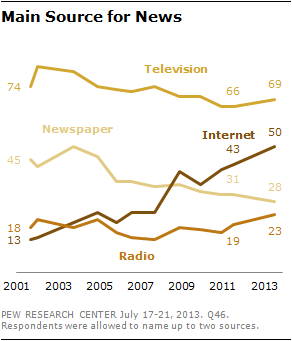The Pew Research Center for the People and the Press  released the chart at right detailing the main sources people get their news from, as part of a larger overview of American attitudes towards news and journalism. As you can see, though both T.V. and newspapers are down from 2001, television has started to swing back up, while newspapers continue to crater. Both the Internet and radio are above where they were in 2001.
released the chart at right detailing the main sources people get their news from, as part of a larger overview of American attitudes towards news and journalism. As you can see, though both T.V. and newspapers are down from 2001, television has started to swing back up, while newspapers continue to crater. Both the Internet and radio are above where they were in 2001.
In response to the popularity of televisions and the Internet, Ted Nesi, of WPRI, posed this idea on Twitter: “TV and Internet arguably have more in common as media (info via screens!) than papers & Internet.”
It caused me to pause and reflect about the barrier to use for each of these four sources of news. I think the commonality all three of the rising news sources (television, the Internet, radio) is that you can get them regardless of whether you want to get them for news, and it never has to be a conscious decision.
Virtually every audio system you can buy comes with a radio, they appear in your car, and prior to the rise of MP3 players, radios were installed on every portable audio device. You can listen to music on a radio or fill your ears with news.
Television isn’t as readily available as the other two, but it’s still virtually everywhere, from bars and restaurants to your home. And it’s easy to switch from reality television, to (more) scripted entertainment, to music, to news. Even within a single channel there can be a diverse range of programming.
The Internet is sort of like television and radio in that it tends to have specialized sources for specific genres, but those genres include everything you could ever want. You want to see a dog riding a skateboard? Check. Read up on what that guy you met in college like one time is doing in Malaysia now? Check. No other medium comes close to the diversity and range of the Internet, your all-in-one stop for everything there is under the sun (and everything that avoids direct sunlight as well). Furthermore, the Internet is now virtually everywhere, thanks to smartphones and wi-fi.
And now this brings us to the poor plight of the newspaper. Here’s the thing, newspapers have to be a major network, and in print, and at least a day behind everything else. Furthermore, unlike television, radio, and the Internet where you can just stumble across news, newspapers don’t have that advantage. Few people just “stumble” across a newspaper (well, maybe the Phoenix). You tend to have to make a conscious decision to go get a newspaper, whether its from your front step or the box. And though they often contain sections related to entertainment, culture, lifestyle, etc.; their name says it all. They’re a “newspaper” and its primary purpose is to deliver news to you.
The point here is not to disparage newspapers. It’s to point out that by their very design, newspapers are disadvantaged in simply getting to their consumer in a way other mediums aren’t. Until the Internet became widely available and used, newspapers were doing just fine. Now, their place in the media landscape is shifting so rapidly that their very future no longer seems assured. That said, despite these disadvantages, they have managed to continue beating radio, which of all media has the lowest cost barrier for consumers.

